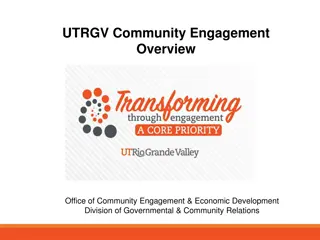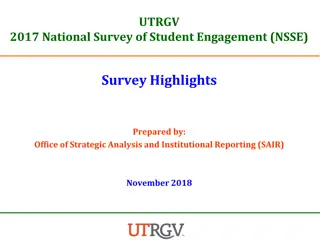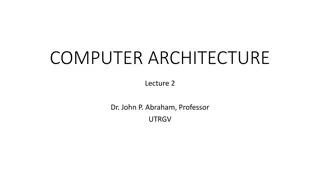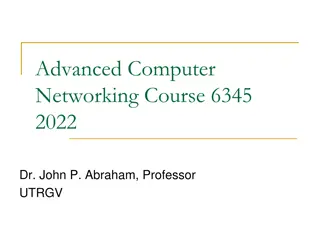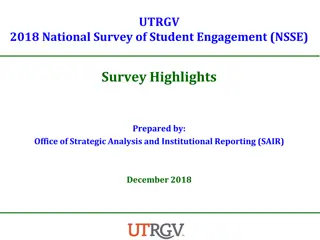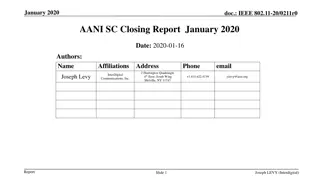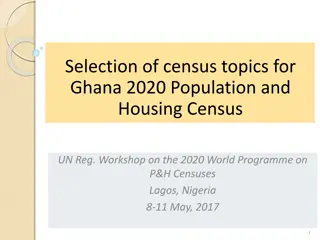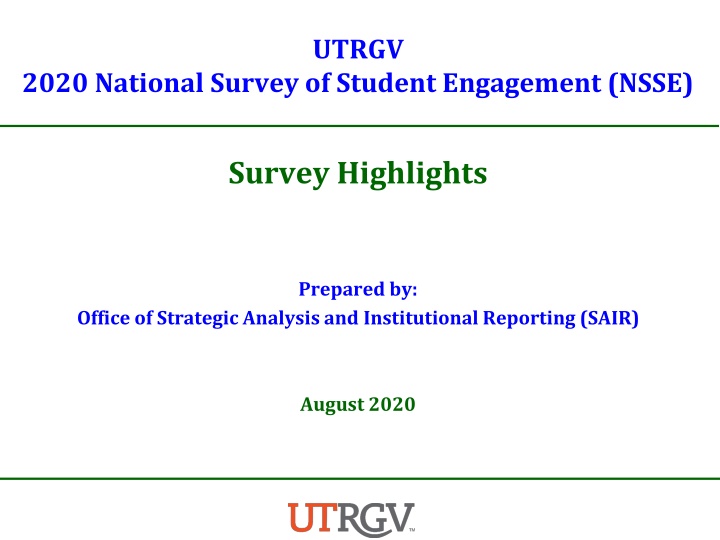
Understanding NSSE Themes for Student Engagement
Explore the National Survey of Student Engagement (NSSE) and its importance in assessing student experiences and engagement in higher education. Learn about the four key themes of NSSE that focus on academic challenge, interactions with faculty, learning with peers, and campus environment. Dive into the engagement indicators within each theme to understand how students engage and learn in different settings.
Download Presentation

Please find below an Image/Link to download the presentation.
The content on the website is provided AS IS for your information and personal use only. It may not be sold, licensed, or shared on other websites without obtaining consent from the author. If you encounter any issues during the download, it is possible that the publisher has removed the file from their server.
You are allowed to download the files provided on this website for personal or commercial use, subject to the condition that they are used lawfully. All files are the property of their respective owners.
The content on the website is provided AS IS for your information and personal use only. It may not be sold, licensed, or shared on other websites without obtaining consent from the author.
E N D
Presentation Transcript
UTRGV 2020 National Survey of Student Engagement (NSSE) Survey Highlights Prepared by: Office of Strategic Analysis and Institutional Reporting (SAIR) August 2020
Outline What is NSSE? Response Rate at UTRGV Four NSSE Themes for Student Engagement Engagement Indicators in NSSE Themes Performance Comparisons Satisfaction with UTRGV First-year students performance Senior students performance Recommendations
What is NSSE? The National Survey of Student Engagement (NSSE) collects information from first-year and senior students about the characteristics and quality of their undergraduate experience. It assesses the extent to which students engage in educational practices associated with high levels of learning and development. The results provide an estimate of how undergraduates spend their time and what they gain from attending their college or university. Institutions use their data to identify aspects of the undergraduate experience that can be improved through changes in policy and practice.
Response Rate Note: UT System includes the following participants - UT Arlington, UTD, UTEP, UTSA, UT Tyler, and UT Permian Basin. UTRGV Peers includes 6 Peer institutions that participated in NSSE 2020. They are New Mexico State University, University of Memphis, University of Missouri-Kansas City, UT El Paso, and UT San Antonio.
Four NSSE Themes for Student Engagement Experiences with Faculty Academic Challenge Students learn firsthand how experts think about and solve problems by interacting with faculty members inside and outside of instructional settings. As a result, faculty become role models, mentors, and guides for lifelong learning. In addition, effective teaching requires that faculty deliver course material and provide feedback in student-centered ways. Two Engagement Indicators investigate this theme: Student-Faculty Interaction and Effective Teaching Practices. Challenging intellectual and creative work is central to student learning and collegiate quality. Colleges and universities promote student learning by challenging and supporting them to engage in various forms of deep learning. Four Engagement Indicators are part of this theme: Higher-Order Learning, Reflective & Integrative Learning, Learning Strategies, and Quantitative Reasoning. Learning with Peers Campus Environment Collaborating with others in mastering difficult material and developing interpersonal and social competence prepare students to deal with complex, unscripted problems they will encounter during and after college. Two Engagement Indicators make up this theme: Collaborative Learning and Discussions with Diverse Others. Students benefit and are more satisfied in supportive settings that cultivate positive relationships among students, faculty, and staff. Two Engagement Indicators investigate this theme: Quality of Interactions and Supportive Environment.
Engagement Indicators in NSSE Themes Academic Challenge Learning with Peers Experiences with Faculty Campus Environment Higher-Order Learning Collaborative Learning Student-Faculty Interaction Quality of Interactions Reflective & Integrative Learning Learning Strategies Discussions with Diverse Others Effective Teaching Practices Supportive Environment Quantitative Reasoning
Performance Comparisons for UTRGV on Academic Challenge First-Year Students Seniors Compared with Compared with Academic Challenge UTRGV Score UTRGV Score UT Carnegie Doctoral UTRGV Peers UT Carnegie Doctoral UTRGV Peers System System 41.3 Higher-Order Learning 38.3 Reflective & Integrative Learning 34.6 37.5 39.1 38.9 Learning Strategies Quantitative Reasoning 27.8 29.3 The Scale is 60 points indicates the score of UTRGV is significantly lower than this comparison group indicates the score of UTRGV is significantly higher than this comparison group A BLANK indicates no statistically significant difference
Performance Comparisons for UTRGV on Learning with Peers First-Year Students Seniors Compared with Compared with Learning with Peers UTRGV Score UTRGV Score UT Carnegie Doctoral UTRGV Peers UT Carnegie Doctoral UTRGV Peers System System Collaborative Learning 33.9 35.4 Discussions with Diverse Others 32.6 32.2 The Scale is 60 points indicates the score of UTRGV is significantly lower than this comparison group indicates the score of UTRGV is significantly higher than this comparison group A BLANK indicates no statistically significant difference
Performance Comparisons for UTRGV on Experiences with Faculty First-Year Students Seniors Compared with Compared with Experiences with Faculty UTRGV Score UTRGV Score UT Carnegie Doctoral UTRGV Peers UT Carnegie Doctoral UTRGV Peers System System Student-Faculty Interaction 23.1 24.5 Effective Teaching Practices 41.0 41.1 The Scale is 60 points indicates the score of UTRGV is significantly lower than this comparison group indicates the score of UTRGV is significantly higher than this comparison group A BLANK indicates no statistically significant difference
Performance Comparisons for UTRGV on Campus Environment First-Year Students Seniors Compared with Compared with Campus Environment UTRGV Score UTRGV Score UT Carnegie Doctoral UTRGV Peers UT Carnegie Doctoral UTRGV Peers System System 44.6 43.2 Quality of Interactions Supportive Environment 37.3 34.3 The Scale is 60 points indicates the score of UTRGV is significantly lower than this comparison group indicates the score of UTRGV is significantly higher than this comparison group A BLANK indicates no statistically significant difference
Satisfaction with UTRGV Percentage of Students Rating Their Overall Experience at their institution as "Excellent" or "Good"
Satisfaction with UTRGV Percentage of Students who would Definitely or Probably Attend this Institution Again
First-Year Students had significantly higher scores on the following as compared to Comparison Institution Groups Faculty: Clearly explaining course goals & requirements Teaching course sessions in an organized way Using examples or illustrations to explain difficult points Providing feedback on a draft or work in progress Providing prompt and detailed feedback on tests or completed assignments Students: Reviewing notes after class Working with other students on course projects or assignments Talking about career plans with a faculty member Discussing academic performance with a faculty member Institution contributes by: Providing experience to writing clearly and effectively Including community-based (service-learning) projects in some courses Thinking critically and analytically Providing the experience to speak clearly and effectively Providing the experience to work effectively with others Providing the experience to develop/clarify a personal code of values & ethics Being an informed and active citizen
First-Year Students had significantly lower scores on the following as compared to Comparison Institution Groups Students: Having interactions and discussions with diverse groups Preparing for class (studying, reading, writing, doing homework or lab work, analyzing data, rehearing, and other academic activities). Participating in a learning community or some other formal program where groups of students take two to more classes together Number of hours spent on preparing for class Participating in co-curricular activities (organizations, campus publications, etc.)
Senior Students had significantly higher scores on the following as compared to Comparison Institution Groups Faculty: Providing feedback on a draft or work in progress Providing prompt and detailed feedback on tests or competed assignments Students: Preparing for exams by discussing or working through course material with other students Working with other students on course projects or assignments Participating in community service or volunteer work Interacting with Students Interacting with Faculty Institution contributes by: Including community-based (service-learning) projects in some courses Providing the experience to develop/clarify a personal code of values & ethics Helping manage non-academic responsibilities (work, family, etc.) Student feeling like part of the community at this institution
Senior Students had significantly lower scores on the following as compared to Comparison Institution Groups Students: Having interactions and discussions with diverse groups
For detailed frequency tables and more information on NSSE Results Visit http://www.utrgv.edu/sair (Look under Data and Reports for Student Survey Results)










